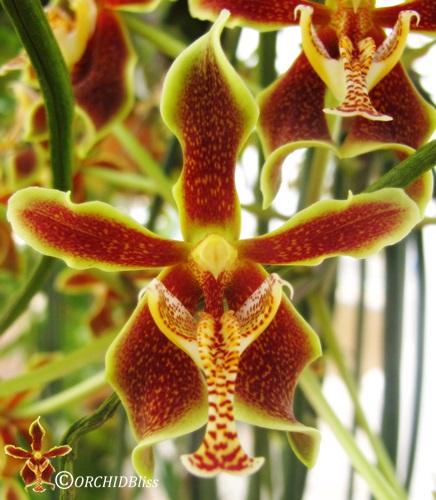First of all, I changed the layout and color scheme.
How do you like the new layout? I like the fixed sidebar on the left because it stays fixed in that position even when you scroll down. Still tweaking here and there, so don't be surprise to see a different layout later.
Maybe not....too much work and time.
Further, I am planning to tweak my wire jewelry site as well.
OK, first post after 5 years is about our Paraphalaenopsis Labukensis (Pps. labukensis).
▼In case you wonder, how it looks like closeup. I use this picture for this blog's logo I changed the logo to another species - Phalaenopsis Violecea (locally called Lundu orchid - will talk about it in another post) as well as for watermark on pictures.
The flower measures between 4-6 cm across.
The flower measures between 4-6 cm across.
Our six plants went into flowering frenzy early of the year after resting for few years...can't remember how many years back. It was rainy season when they bloom - they love moisture.
▼Close up of Paraphalaenopsis labukensis's flower.
▼The leaves can grow up to 3 meters. Ours is about 1.5 meters in length. Some are longer.
▼Closeup of the flower and blooms.
▼This is how they look like from the bottom. Our Pps are planted in tilted perforated pots with charcoal to allow the leaves to hang down.
▼In a row.
▼Wonder why this is of lighter color. Dear hubby (DH) also don't know why but they are the same species nevertheless.
The name labukensis is named after where this orchid can be found i.e. its origin.
If you google for Labuk, then you will be directed to Labuk, a place located in eastern Sabah.
If you are from Sabah, then you would know that this area has been subjected to various human activities, of which oil palm plantation development is the most threatening to this species and many other species endemic to the area.
Hopefully some conservation works in that area and nearby help to conserve and protect them before it is too late.
Pps. labukensis Care
- Shade-loving and like good deal of moisture
- Good ventilation and pot drainage
- They can be grown logs, slabs and coconut husk
- Shelter from rain and dripping water
- Repotting - every 3 to 5 years








No comments:
Post a Comment
I love to hear from you. Thank you!